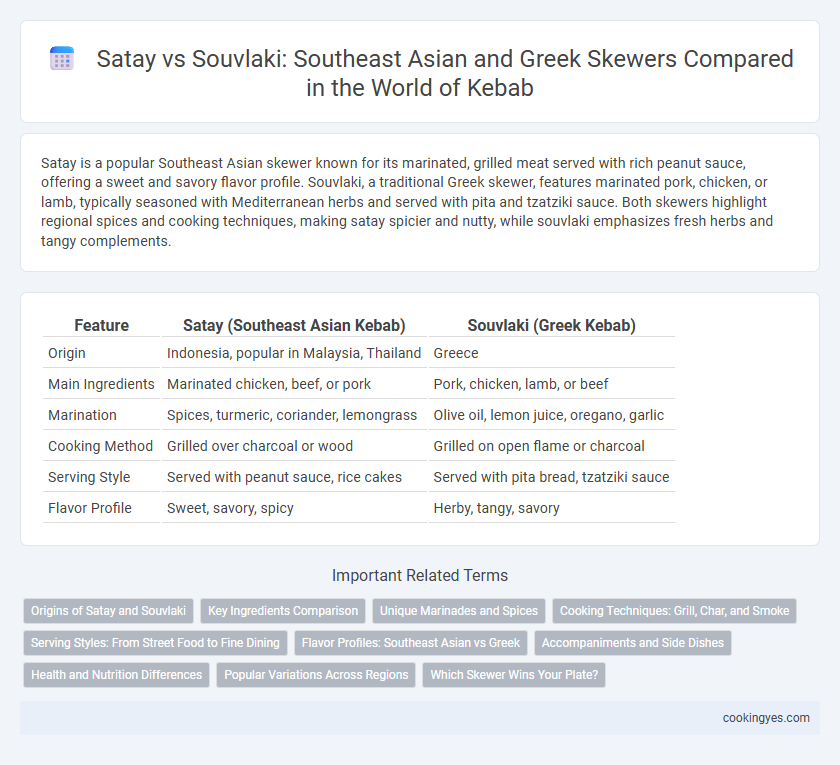Satay is a popular Southeast Asian skewer known for its marinated, grilled meat served with rich peanut sauce, offering a sweet and savory flavor profile. Souvlaki, a traditional Greek skewer, features marinated pork, chicken, or lamb, typically seasoned with Mediterranean herbs and served with pita and tzatziki sauce. Both skewers highlight regional spices and cooking techniques, making satay spicier and nutty, while souvlaki emphasizes fresh herbs and tangy complements.
Table of Comparison
| Feature | Satay (Southeast Asian Kebab) | Souvlaki (Greek Kebab) |
|---|---|---|
| Origin | Indonesia, popular in Malaysia, Thailand | Greece |
| Main Ingredients | Marinated chicken, beef, or pork | Pork, chicken, lamb, or beef |
| Marination | Spices, turmeric, coriander, lemongrass | Olive oil, lemon juice, oregano, garlic |
| Cooking Method | Grilled over charcoal or wood | Grilled on open flame or charcoal |
| Serving Style | Served with peanut sauce, rice cakes | Served with pita bread, tzatziki sauce |
| Flavor Profile | Sweet, savory, spicy | Herby, tangy, savory |
Origins of Satay and Souvlaki
Satay originates from Southeast Asia, particularly Indonesia and Malaysia, where marinated meat is skewered and grilled over charcoal, often served with peanut sauce. Souvlaki traces back to ancient Greece, characterized by small pieces of meat grilled on a skewer, commonly served with pita and tzatziki sauce. Both dishes reflect their distinct cultural heritages and regional ingredients, highlighting diverse grilling traditions.
Key Ingredients Comparison
Satay features marinated meat skewers seasoned with turmeric, lemongrass, garlic, and coconut milk, typical of Southeast Asian cuisine, while souvlaki relies on Greek flavors like oregano, olive oil, lemon juice, and garlic for marination. Satay is commonly served with a rich peanut sauce, emphasizing a sweet and savory profile, whereas souvlaki is accompanied by tzatziki, a yogurt-based sauce with cucumber and dill, highlighting freshness. The distinct herb and spice combinations illustrate cultural influences, with satay embracing bold, aromatic spices and souvlaki focusing on Mediterranean herbs and citrus.
Unique Marinades and Spices
Satay features a rich blend of turmeric, coriander, lemongrass, and coconut milk creating a sweet and savory marinade, essential to Southeast Asian cuisine. In contrast, Greek Souvlaki highlights oregano, garlic, lemon juice, and olive oil, imparting a vibrant Mediterranean flavor profile. These distinct marinades and spices fundamentally define the cultural and culinary identity of each skewer variant.
Cooking Techniques: Grill, Char, and Smoke
Satay relies on marinated meat skewers grilled over open flames, producing a fragrant char infused with coconut milk and spices typical of Southeast Asian cuisine. Souvlaki employs pork, chicken, or lamb skewers cooked over charcoal grills, offering a smoky, slightly charred exterior rooted in Greek culinary traditions. The grilling techniques highlight regional flavor profiles, with satay emphasizing smoky sweetness and souvlaki delivering robust, herb-infused smokiness.
Serving Styles: From Street Food to Fine Dining
Satay, originating from Southeast Asia, is typically served with rich peanut sauce and rice cakes, often enjoyed as flavorful street food or casual gatherings. Souvlaki, a staple of Greek cuisine, features grilled meat skewers commonly paired with pita, tzatziki, and fresh vegetables, transitioning seamlessly from vibrant street stalls to upscale dining establishments. Both dishes showcase distinct serving styles that highlight regional ingredients and cultural dining customs, reflecting their unique culinary heritage.
Flavor Profiles: Southeast Asian vs Greek
Satay features a rich, savory flavor profile enhanced by aromatic spices such as turmeric, coriander, and lemongrass, often accompanied by a creamy peanut sauce that adds a sweet and nutty dimension. Souvlaki showcases a Mediterranean blend of herbs like oregano, garlic, and lemon, imparting a bright, tangy taste that highlights the simplicity of grilled meat. The contrast between satay's bold, spiced complexity and souvlaki's fresh, citrusy notes reflects the distinct culinary traditions of Southeast Asia and Greece, respectively.
Accompaniments and Side Dishes
Satay, a popular Southeast Asian skewer, is traditionally served with peanut sauce, rice cakes (ketupat), and cucumber salad, enhancing its savory and slightly sweet flavors. Greek souvlaki is commonly paired with pita bread, tzatziki sauce, and a fresh Greek salad featuring tomatoes, cucumbers, and olives, providing a tangy and refreshing contrast. Both skewers emphasize bold accompaniments that reflect their regional culinary identities while complementing the grilled meat.
Health and Nutrition Differences
Satay, a popular Southeast Asian skewer, typically uses marinated chicken or beef rich in protein and low in fat, often paired with nutrient-dense peanut sauce containing healthy fats and antioxidants. Souvlaki, a Greek skewer, emphasizes lean pork or lamb marinated in olive oil, lemon, and herbs, contributing heart-healthy monounsaturated fats and anti-inflammatory compounds. Both skewers offer a balanced mix of protein and healthy fats, but souvlaki tends to have higher omega-9 fatty acids from olive oil, while satay provides more vitamin E and magnesium through its peanut-based sauce.
Popular Variations Across Regions
Satay, a staple in Southeast Asian cuisine, features marinated meat skewers often served with a rich peanut sauce, with popular variations found in Indonesia, Malaysia, and Thailand. In contrast, Greek souvlaki consists of grilled meat cubes, typically pork or chicken, seasoned with herbs like oregano and accompanied by tzatziki sauce, pita bread, and fresh vegetables. Both dishes showcase regional spices and cooking techniques that highlight the cultural diversity within their respective culinary traditions.
Which Skewer Wins Your Plate?
Satay, a Southeast Asian skewer, features marinated meat grilled with rich spices and served with peanut sauce, offering a sweet-savory flavor profile. Souvlaki, a Greek skewer, emphasizes tender, herb-infused meat often paired with pita and tzatziki, delivering a refreshing and zesty taste. The choice between satay and souvlaki depends on preference for bold, nutty Indonesian flavors or Mediterranean simplicity, making either a winner on your plate.
Satay vs Souvlaki for Southeast Asian vs Greek Skewers Infographic

 cookingyes.com
cookingyes.com